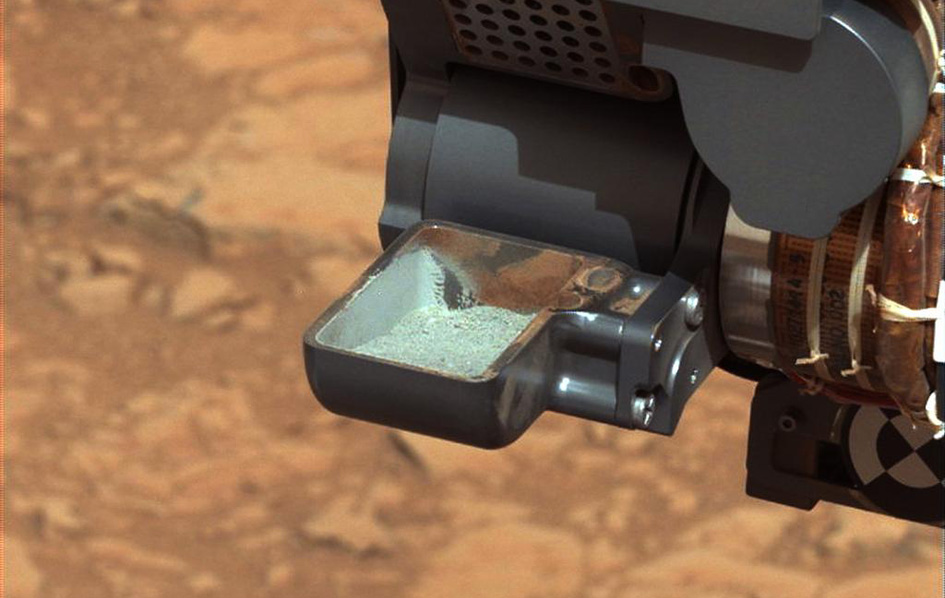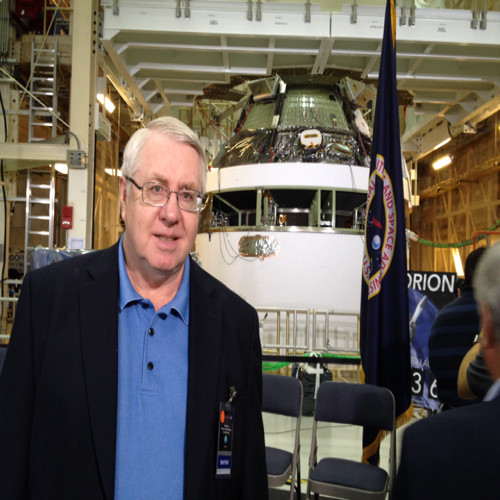CuriousMars: Rover Poised to Test For Organics Where Habitability Potential is High

The Mars rover Curiosity’s team is beginning to amass enough diverse science data to actively consider whether the area around its first drilling site was potentially habitable.
At the same time the science team is readying the rover’s most powerful instruments to search for organic carbon and minerals supportive to life in its first sample of gray powdered subsurface rock.
“Right now we hopefully are on the pathway to characterizing this as a habitable environment,” said Curiosity Mission Scientist John Grotzinger of Caltech.
Video shows the dozens of moves the rover’s 7.5 ft. arm and its 60 lb. science turret must make for every sample acquisition to flow sample powder down specific paths aided by Martian gravity. Credit: NASA/JPL-Caltech
Although some members of the nearly 400 person science team are expressing concern that the $2.5 billion rover has not yet set off for of Mt. Sharp 6 miles (10 km.) distant, Grotzinger has not ruled out more drilling in the Yellowknife Bay area that increasingly looks like an ancient lakebed.
The Mission Scientist says what the team has found at the current site would have been deemed an equally sensational find had the rover landed on the flanks of Mt. Sharp, the mission’s primary objective. “We would have considered it very much the stuff we choose the landing site to go find,” said Grotzinger.

Graphic shows how CHIMRA sample handling units on instrument turret appears in cutaway with powdered sample flow path indicated. Credit: NASA/JPL-Caltech.
“We are just going to take it one step at a time,” he said. “We have this first sample, we’ll process it, see what we get and based on that decided what to do next. The mission is discovery driven and we have no quotas,” Grotzinger said at a February 20 briefing.
Determining habitability requires measuring a complex matrix of data concerning the past permanence of water, the radiation environment, the mineralogy of the site, ancient atmospheric conditions and other factors.
Grotzinger stressed that while the team may or may not find organic carbon at the rover’s current location that will not necessarily affect whether it is judged to have been habitable for possible ancient Martian microorganisms.
“Obviously we are focused on organics, but organics and habitability are two somewhat independent issues”, he said.

The CHIMRA sample handling unit has been robotically split open to reveal the 150 micron filter and the locations of problem welds on ground test unit. Credit: NASA/JPL-Caltech/MSSS.
The finding of gray colored internal rock material and gray rocks once their red surface veneer has been brushed off by the Dust Removal Tool is a major find to scientists.
“It is pretty exciting to us that you just brush below this surface veneer and the rocks are a completely different color,” said Joel Hurowitz, sampling system scientist for Curiosity, at the Jet Propulsion Laboratory. “We are seeing a whole new coloration for Mars, and it’s exciting,” he said.
“For us this is a prospective location [for organics],” said Grotzinger. “All things being equal its better to have a gray color than red because oxidation is something that can destroy organic compounds”.

Video shows the Goddard Space Flight Center’s SAM instrument’s primary and backup sample receptacle covers being exercised. Credit: NASA/JPL-Caltech/MSSS.
“We are excited because this points us in the right direction,” said Grotzinger. “But even when everything goes right, it is still an accident of fate to preserve organics. So the team will have to separate at some point the pursuit of what may have been a habitable environment from what may or may not be an environment that preserves organics.”
Curiosity is about to shed some critical light on the issue with the processing of subsurface rock material obtained by the rover’s percussion drill on February 8/Sol 182.
Some software glitches over the last week held up operations for 3-4 days, but those have now been cleared.

Curiosity carries five cylindrical blocks of organic check material for use in a control experiment if the SAM laboratory detects any organics. A challenge will be to confirm that these molecules are truly Martian, not stowaways from Earth. The organic check material is a silicon-dioxide ceramic laced with small amounts of synthetic fluorinated organic chemicals not found in nature on Earth and not expected on Mars. Credit: NASA/JPL-Caltech/MSSS.
On February 20/Sol 193, the instrument turret on the arm was maneuvered so the powdered rock sample inside the turret’s Collection and Handling CHIMRA device would fall into the unit’s closed scoop. The scoop was then opened revealing the rock powder for imaging and inspection.
Over the next few days the rover manipulator arm will first be tilted back and forth to run the tablespoon’s worth of powdered rock sample through a 150 micron screen for 20 minutes.
The original plan was to sift the material for 60 minutes as was done for the sand sample taken at the initial Rocknest sample site.

The Canadian Alpha Particle X-ray Spectrometer on the instrument turret was used 25 times on the rocks in the drilling area to provide elementary composition data. Credit: NASA/JPL-Caltech/MSSS.
But in late November, one of two ground test CHIMRA units being tested at the Jet Propulsion Laboratory for lifetime wear popped welds where the 150 micron sieve is sealed onto its frame. When this occurred, the tests continued without problems as the filter slowly began to unzip from the frame. But it still was able to complete a simulated 2 Earth year mission, but also additional years of extended life testing.
Precautions are being taken to make sure something similar does not occur on Curiosity, said Daniel Limonadi, lead systems engineer for Curiosity’s surface sampling and science system, at JPL.
Instead of a 60 minute of sample/sieve motions, only 20 minute will be done at a time. Internal mechanical “thwacks” to keep the material moving will also be reduced. The sample will then be inspected, and if needed another 20 minute filter session will be conducted. The number thwacks overall will be reduced to decrease loads on the welds.

The Mars Hand Lens Imager with pink tinted lens cover was used about 100 times to obtain close up images of rock and drill features in the drilling area. To the right are the brushes of the Dirt Removal Tool that has discovered the red Martian veneer can be easily brushed off Yellowknife Bay rock to reveal their true gray color. Credit: NASA/JPL-Caltech/MSSS.
After an initial 20 minute filtering, more imagery of the sample in the scoop will be taken to ensure that particle size looks uniform before a “Go” is given for delivery to the Curiosity’s two internal laboratories.
Throughout its stay in the John Klein area, the Spanish weather station team has been taking wind direction and velocity measurements to determine the best time for the arm to deliver samples to the instruments to reduce the chance it will blow away.
First a pinch of the sample will be dropped into the receptacle atop the rover deck for the NASA Ames Research Center’s CheMin Chemistry and Mineralogy instrument. It will use X-Ray diffraction to identify and measure the abundances of various minerals in the drilled rock powder (see CuriousMars February 14).
A day or so later if all is well, a second “Go” will be given for delivery of a similar, half an aspirin’s worth of powdered rock to the NASA Goddard Space Flight Center SAM Sample Analysis at Mars instrument.

In addition to a gray subsurface rock sample, the rover’s color Mastcam has found other gray rocks around Curiosity where the wind has blown the red Martian veneer off. Credit: NASA/JPL-Caltech/MSSS
SAM will heat its samples to a high temperature to determine even more precise mineralogical data and the presence of any organic carbon that could indicate past life was present at when the rock was formed.
Initial analysis indicates the rock drilled is an extremely fine grained mudstone or siltstone with basaltic content, although data on the minerals that have been formed from elements within the rock will be the most important findings, Grotzinger told CuriousMars.
If SAM finds organics that discovery is not likely to be revealed until members of the science team can brief it directly before hundreds of their peers at the 44th Lunar and Planetary Science Conference in Houston March 12-22.

The JPL team developed 8 rover type drills, including the one on Curiosity. To prove the system, they began years ago drilling what now totals 1,200 holes on dozens of different types of rock. The rocks here were drilled in 2007 as part of drill lifetime testing at JPL. Credit: NASA/JPL-Caltech.
Louise Jandura, the sample system chief engineer for the Curiosity drill at JPL says the ability to take samples from deep within Martian rocks could reveal 3-4 billion years of Martian history.
A week ago in this space I wrote that Curiosity had achieved “the first subsurface rock sample acquired on another planet”.
That created a debate among readers about whether Apollo astronauts using drills on the Moon had actually been first. Putting aside the issue of whether the Moon equates to a planet, I still say no because none of the Apollo drills were used to take samples from within rocks, only the lunar regolith. The drills on the three Soviet sample return landers also only drilled into regolith.
I erred not about the Moon, but rather Venus.

Note the “soil drill” on the side of one of the Venera 13 -14 pair of spacecraft launched separately in 1981 for 1982 landings. As tall as a person, each lander weighed about 1,675 lb. (760 kg.) and functioned on the surface in 855 deg. F (457 deg. C) temperatures. Large ring is descent airfoil which lowered vehicle slowly in 84 Earth atmospheric pressure. Credit: Don P. Mitchell.
I failed to note that the Soviet Venera 13 and 14 Venus landers of 1982 both carried screw-like drills mounted on their landing rings. The Venera drills were designed if necessary to bore 1 inch (2. 54 cm. ) into hard basaltic rock. Neither drill actually bored into anything hard–or did they? They could only drill on what happened to be directly under the screw, whether regolith or rock.
According to both Soviet and U. S. scientists, data indicates the drills bored into soft “compacted ash” , tuff-like material after which a vacuum system sucked in grains of the basaltic stuff for a successful analysis by X-ray fluorescence spectrometers on each lander.
Soviet space analyst Don P. Mitchell has a superb website covering all Soviet lunar and planetary spacecraft where detailed images from all six Venera lander missions can be seen.

Graphic shows design of the Soviet Venera “screw” drills designed to penetrate 1 inch (2.54 cm.) into solid basaltic rock. They found no hard rocks but “compressed ash” type material. Credit: Don P. Mitchell.
Between 1975-1982 the Soviet Union landed 6 of these highly successful spacecraft on the surface of Venus. The Venera 9-10-11-12-13 and 14 landers all had similar designs that weighed up to 760 kg. (1,675 lb.). They functioned at 84 Earth atmospheres of pressure at 855 deg. F (457 C.). Only the final two missions carried drills.
The Venera 13 and 14 landings were followed two years later by a detailed report on their surface operations by the late Yuri A. Surkov, who headed planetary programs for the famed Vernadsky Institute. His presentation during the height of the Cold War before the 14th Lunar and Planetary Science Conference in Houston highlights the Veneras’ unsurpassed achievement in planetary exploration: (Visit Google Scholar for ” New data on the composition, structure, and properties of Venus rock obtained by Venera 13 and Venera 14“)
—
Listen to podcast of this NASA media teleconference related to this story:
– MP3 File
– Space Talk @ SpaceRef RSS XML Podcast Feed
– Podcast on iTunes








